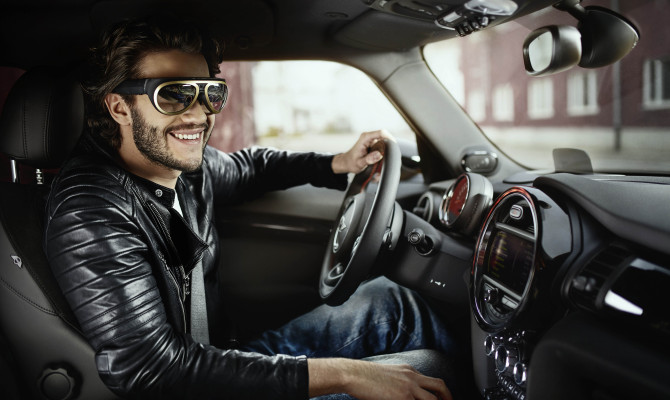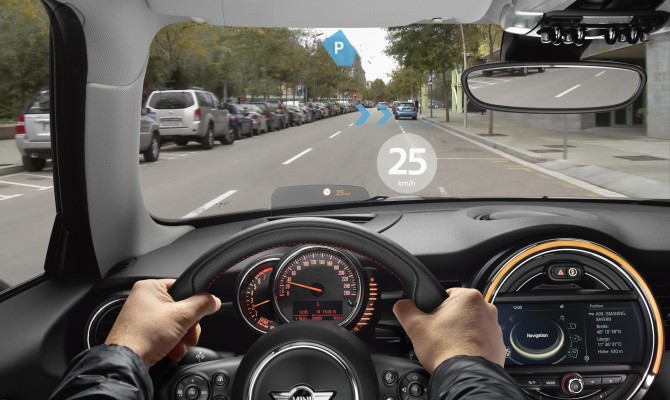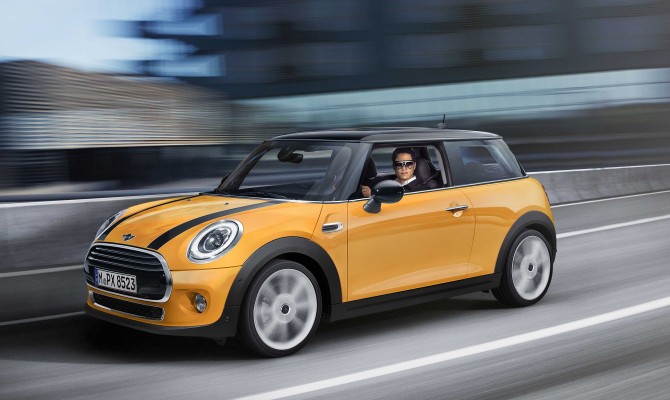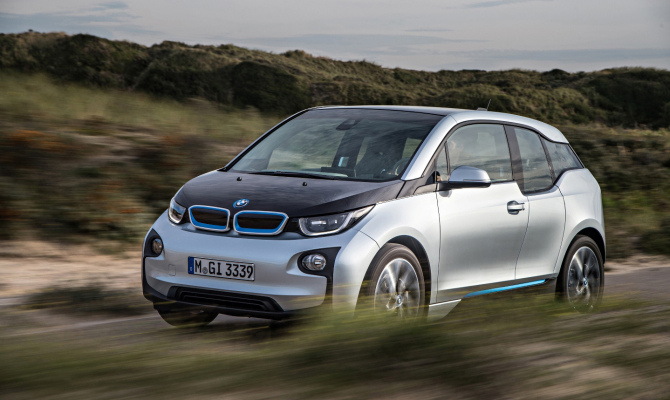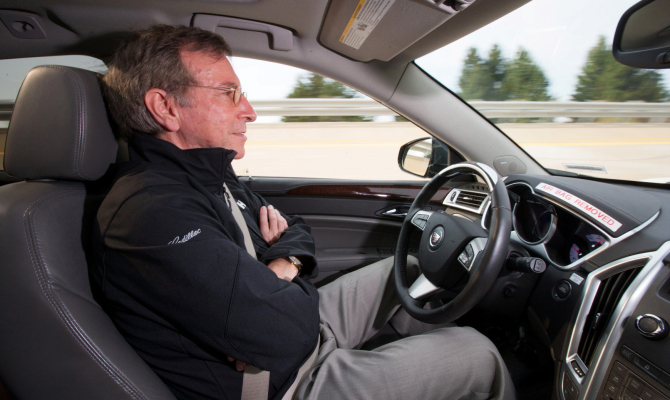Cars that are equipped with the new traffic jam assist with autonomous steering, braking and acceleration, up to 60 km/h, will feel like driving a spaceship.
Nine out of ten (91 percent) support the compulsory introduction of camera technology in all autonomous vehicles.
“Using see-through technology, the eyewear projects information in the driver’s direct field of view without concealing other traffic.”
MINI is bringing a completely new meaning to driving glasses.
At the Shanghai Auto show, the BMW sub-brand has offered first sight of its revolutionary eyewear.
“MINI Augmented Vision gives an insight into how intelligent connectivity between a MINI car and eyewear into which relevant content is projected might work in the future,” explained Dr. Jörg Preißinger, project-manager MINI Augmented Vision, BMW Group research and technology.
“Working with several Qualcomm companies, we have created an interlinked system and augmented reality eyewear with a characteristic MINI design that revolutionise the experience both in and outside the vehicle. This prototype with its customised, interactive functions succeeds in fusing augmented reality with the brand’s trademark sense of lifestyle.”
Using see-through technology, the eyewear projects information in the driver’s direct field of view without concealing other traffic.
“We are proud to have helped develop a breakthrough augmented reality interface between eyewear and the automobile,” said Jay Wright, Vice President, Qualcomm Connected Experiences, Inc. “MINI Augmented Vision offers a compelling example of what’s possible today, and what we can expect in the future.”
The technology will enable drivers to enter destination details outside of the car then transfer the information to the onboard navigation. The navigation will then display from the current location to the vehicle or from the vehicle to the final destination. Direction instructions in the shape of coloured arrows will appear projected on the road ahead at the turns.
Current speed and posted speed limits will be projected into the driver’s field of view above the steering wheel, without obscuring the road ahead.
A small icon shows in the eyewear when a message is received and the SMS/message can then be read out by the “car”.
Now this is an amazing feature: A virtual view through parts of the vehicle (such as A-pillars and doors) makes visible external areas or objects concealed by the car’s body parts!
“Customers may not have asked for an aluminum body, instead of steel, but there’s solid reasoning behind this change…”
Steel is out and aluminum is the new lightweight “in” material for auto body panels.
Hang on a minute, maybe it’s Carbon Fibre-Reinforced Plastic? These two materials, plus a very different type of hybrid, are entries for the 2015 AJAC Best New Innovative Auto Technology Award.
Ford – F150 Aluminum Body
“If I had asked people what they wanted, they would have said faster horses,” is a quote attributed to Henry Ford, founder of the Ford Motor Company.
The Ford F150 has been the best-selling in truck sold in Canada for the last four years. Customers may not have asked for an aluminum body, instead of steel, but there’s solid reasoning behind this change.
Aluminum reduces body weight by 40-to-50 per cent. It’s more resistant to corrosion issues and it’s 100 per cent recyclable. In addition to fuel efficiency benefits, a lighter vehicle also has positive influences on braking, handling, ride and acceleration.
A special heat treatment, developed by Ford, nearly doubles (compared to steel) the strength of the military grade aluminum (magnesium) alloy body panels used in the new F150, making them more resistant to dents. Much of the raw aluminum also comes from Canada, as does a good portion of the secondary processing.
Ford’s experience with aluminum body parts actually goes all the way back to the 1915 Model T. In 2009 it secretly built an aluminum body F150, for test purposes, and Ford engineers have also been able to draw from experience in developing current production vehicles such as the all-aluminum body Jaguar XJ.
BMW Carbon Fibre-Reinforced Plastic
The BMW i3 and i8 are two new all-electric vehicles with ultra-light-weight bodies made from Carbon Fibre-Reinforced Plastic (CFRP). It’s a man-made material that’s extremely strong and it’s about 30 per cent lighter than aluminum. This is the first time that the entire body of a production car has been made with a carbon fiber compound.
CFRP is a composite material consisting of carbon fiber surrounded by a plastic matrix (resin). It’s completely resistant to corrosion and is expected to have a substantially longer useful life than metal. It also remains stable under all climatic conditions, according to BMW, even when it’s exposed to large temperature fluctuations.
Carbon Fiber is not a new material to auto racing enthusiasts, where its exceptional strength and light weight make if an ideal body material. CFRP has also been used to make trunk lids, roofs and even drive-shafts in the sporty M Series models by BMW. The main drawback to using carbon fiber in mainstream production vehicles, however, has been its cost, which brings up a Pacific Northwest connection,
All of the carbon fiber use in i3 and i8 comes from a new production plant in Moses Lake, Washington State. In fact, BMW has plans to triple capacity in Moses Lake and make it the world’s largest carbon fiber production plant. More and more BMW models are expected to include components made with CFRP and large-scale production is expected to reduce unit costs.
Honda/Acura – Sport Hybrid SH-AWD
The hybrid edition of the new Acura RLX includes the first-ever electronic (torque vectoring) Super Handling All-Wheel Drive (SH-AWD) system used in a production hybrid vehicle. This RLX is also the most powerful Acura production model ever built. Combined peak output is 377 horsepower and peak torque to the front wheels is 273 lb-ft at 4,700 rpm. Yet, its fuel consumption is incredibly low, at just 8.0/ 7.5/ 7.7 L/100km (city/highway/combined).
The hybrid powertrain includes three electric motors, one up front and two in the rear, and they all provide both power assist and regenerative charge to a battery pack. The gas engine is a 3.5-litre, 310-horsepower V6 with Variable Cylinder Management that’s linked with the 7-speed dual-clutch transmission.
Acura’s super-handling all-wheel-drive uses “torque vectoring” to create a yaw moment that helps the RLX turn effortlessly. It functions like an enhanced differential that sends more power to the outside rear wheel during cornering. And, like magic, you’re a much better and smoother driver. The RLX’s sophisticated hybrid system can also allows it run strictly on battery power with the rear motors driving the vehicle.
The 2015 AJAC Best New Auto Safety Technology Award will be announced at the Montreal Auto Show on January 15, 2015.
“The goal of Super Cruise technology is to increase the comfort of an attentive driver on freeways, both in bumper-to-bumper traffic and on long road trips…”
“Take me home Super Cruise” could be a command that future Cadillac owners may be saying to their automobile, in the not-too-distant future.
GM’s luxury brand seems likely to be first automaker to offer a fully automated driving feature in a production vehicle. Super Cruise is one of three entries vying for the 2015 AJAC Best New Auto Safety Technology Award. A similar entry from Honda called AcuraWatch takes us to the brink of automation and another GM entry will be of interest to those who like to cruise the internet.
GM – Super Cruise
Super Cruise is the working name that GM has given a yet to be released automated driving technology that will (or can) allow hands-off-the-wheel lane following, braking and speed control, in certain highway driving situations. The goal of this technology is to increase the comfort of an attentive driver on freeways, both in bumper-to-bumper traffic and on long road trips.
The claimed safety value of Super Cruise is that it could mitigate many traffic collisions and improve traffic congestion. The system sends and receives basic safety information such as location, speed and direction of travel between vehicles that are approaching each other. It will warn drivers and can supplement active safety features, such as forward collision warning, already available on many production cars.
Super Cruise will also add a new lane-centering technology that relies on forward-looking cameras and other sensors to detect markings, curves and other road characteristics. It will also use a series of alerts to communicate with the driver based on human factor research conducted on test tracks.
A simulator is also being used to measure driver eye glance behavior and control interactions in computer-generated automated driving situations.
A combination of radar, ultrasonic sensors, cameras and GPS map data are used by Super Cruise to provide 360 degrees of crash risk detection bubble around the vehicle and enhanced driver assist features. Super Cruise is still undergoing real-world driving assessments and is expected to make its way into Cadillac production models in 2017.
Honda/Acura – AcuraWatch
A system that takes vehicle operation to the brink of automation, AcuraWatch is a suite of driver-assist technologies that’s offered in the Technology and Elite editions of the new Acura TLX.
An interesting new tech included in this package is the Adaptive Cruise Control (ACC) with Low-Speed Follow (LSF). Unlike other systems of this ilk, it uses both grille-mounted (millimeter-wave) radar and a windshield mounted camera to monitor and maintain a preset vehicle speed and following distance interval to the vehicle directly ahead.
The Low-Speed Follow feature is designed primarily for use in stop and go traffic. If the vehicle ahead slows to a stop, the TLX will also come to a stop. If the vehicle ahead then moves within 3 seconds, the TLX will automatically resume Low-Speed Follow mode. If the vehicle ahead does not move within 3 seconds, then the driver can resume Low Speed Follow by pressing the “RES” switch up or down, or by taping the gas pedal.
Other systems included in the AcuraWatch package include Multi-Angle Rearview Camera and Cross Traffic Monitor, Forward Collision Warning, Collision Mitigation Braking System, Lane Departure Warning, Lane Keeping Assist, Road Departure Mitigation and Blind Spot Information.
GM – 10th Generation OnStar
A 10th generation of GM’s OnStar telematics system with 4G LTE has been rolled out in most of its 2015 model year vehicles. It basically turns the vehicle into a WiFi hotspot that allows occupants to connect up to seven personal devices (smartphones, laptops, tablets etc.) and have them work just like they do at home.
The 4GLTE feature also enhances OnStar’s array of safety and security services and provides a more personal experience as the OnStar agent can stay on the line as they manage the vehicle data interface. A new addition is remote diagnostic, which provides a customer with a monthly health status on their vehicle and it can also assist with arranging a maintenance appointment.
A clever smartphone app, called OnStar RemoteLink Key Fob Services, allows an owner to lock or unlock doors, activate the horn and lights, and remotely start a properly-equipped vehicle. It’s included free for five years. OnStar is standard in all 2015 GM vehicles and advisors currently respond to approximately 185,000 calls every day.
All three technologies are competing for the 2015 AJAC Best New Auto Safety Technology Award, which will be announced at the Montreal Auto Show on January 15, 2015.
Recent Comments
- { Enjoyed your Forest of Bowland in the BMW X5M, particularly the photo of the BMW in front of the main part of Stonyhurst College where... }
- { Bantam designed the Jeep, not Willy's or Ford. The American military gave the original Bantam prototype to Willys and Ford to copy. There is plenty... }
- { All Escalades come with a 6.2-lilter V8 engine that produces 420 horsepower. A six-speed automatic is the only transmission offered and drives the rear wheels.... }
- { Alexandra is an excellent journalist. }
Popular Posts
- Journey to a ‘Sparkling’ Luxury Okanagan Resort “Four lucky readers will put a Dodge Journey’s weekend-...
- The Need For Speed: Hike Those Highway Limits More than half of those polled believe the province sho...
- Drives-U-Crazy… Erratic drivers. An early morning drive from Kelowna to Vancouver is nor...
- Readers Respond: The Pros and Cons of Increasing B.C. Speed Limits Increasing the speed limits will only increase risk to...
- Honda CR-V Review: The Compact Crossover To Get Things Done The CRV is a very stylish and aerodynamic crossover veh...


